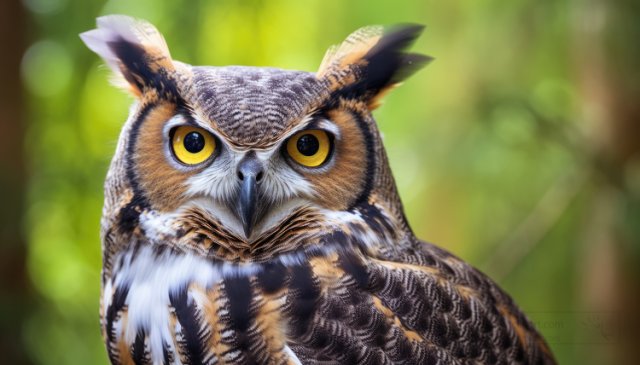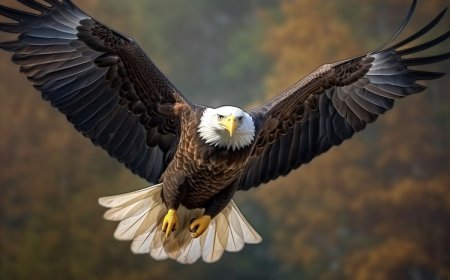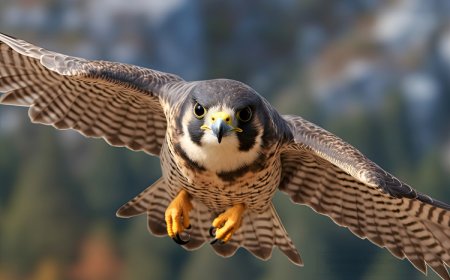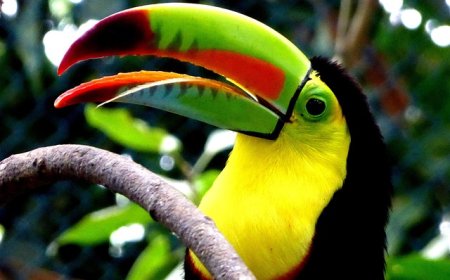Great Horned Owl Facts for Kids: Diet, Nesting, and Silent Flight
Learn about great horned owls in this kid-friendly guide. Discover their diet, nesting habits, and how they hunt silently at night.

🦉🌙 Great Horned Owls: The Powerful Hunters of the Night
Great horned owls are among the largest and most widespread owls in the Americas. These birds are known for their piercing yellow eyes, feather tufts that look like ears (called “horns”), and deep, booming hoots that echo through forests and fields at night.
Sometimes called the “tiger of the sky,” the great horned owl is a fearless predator that can take down prey larger than itself. Its strength, stealth, and adaptability have helped it thrive from Arctic tundra to tropical rainforests.
🧬 Scientific Classification
Great horned owls belong to the Strigidae family, which includes most of the world’s true owls.
Classification:
Kingdom: Animalia
Phylum: Chordata
Class: Aves
Order: Strigiformes
Family: Strigidae
Genus: Bubo
Species: Bubo virginianus
The scientific name Bubo virginianus means “horned owl of Virginia,” where the species was first described.
🦉 Description and Adaptations
Great horned owls are large, powerful birds with thick bodies, big heads, and long tufts that look like ears.
Size and Features:
Length: 18–25 inches (46–64 cm)
Wingspan: 3.3–4.8 feet (1–1.5 m)
Weight: 2–5.5 pounds (0.9–2.5 kg)
Adults have mottled brown and gray feathers with a white throat patch. Their eyes are bright yellow, and their large talons are covered in soft feathers to muffle sound when flying.
Adaptations:
Silent flight thanks to special fringed feathers that break up air noise.
Excellent night vision—their eyes are so large they cannot move in their sockets.
Rotating neck—they can turn their heads 270 degrees.
Strong grip—their talons can exert 300 pounds of pressure per square inch.
🌎 Habitat and Range
Great horned owls are extremely adaptable and live in almost every habitat across the Americas.
Habitats Include:
Forests and woodlands
Deserts
Grasslands and wetlands
Cities and suburbs
Range:
From northern Alaska and Canada all the way to South America.
They are sometimes called “cat owls” because their large tufts resemble cat ears.
🐇 Diet and Hunting Behaviors
Great horned owls are carnivores and one of the most powerful night hunters.
Typical Diet:
Rabbits and hares
Mice and rats
Skunks (they are immune to the smell!)
Snakes and other birds, even other owls
They usually hunt by perching silently, then swooping down on prey. Their flight is so quiet that prey often has no warning.
🪺 Reproduction and Nesting
Great horned owls do not build their own nests. Instead, they take over nests made by other large birds, like hawks or herons.
Nesting Facts:
They may also use tree cavities or cliffs.
Females lay 2–3 eggs in late winter.
The female incubates the eggs for about 30–37 days, while the male brings food.
Chicks fledge at 6–9 weeks old but stay near the nest for months.
🛡️ Conservation Status
Great horned owls are common and widespread. They have adapted well to living near people and are not endangered.
However, they can be harmed by:
Collisions with cars and power lines.
Poisoning from eating rodents that have eaten rodenticide.
Overall, they are listed as Least Concern and remain one of the most successful owls in North America.
✨ Fun Facts About Great Horned Owls
Their hoot can be heard up to a mile away.
They are sometimes called the “hoot owl.”
They can swallow prey whole and cough up pellets of bones and fur.
Their eyes are larger than human eyes, even though the owl is much smaller.
They are one of the few animals that regularly eat skunks.
📝 Kid-Friendly Summary
Great horned owls are large owls with feather tufts that look like horns. They live all across the Americas and hunt at night, using their sharp talons and silent flight to catch rabbits, mice, and other animals. They don’t build their own nests but take over old ones. Great horned owls are common and very important to the ecosystem.
🧠 Vocabulary Words
Word Definition
Talon A bird’s sharp claw used for hunting.
Carnivore An animal that eats other animals.
Incubate Keeping eggs warm until they hatch.
Fledge When young birds leave the nest and learn to fly.
Mottled Having spots or patches of color.
Raptor A bird of prey with keen eyesight and sharp talons.
Pellet A ball of bones and fur coughed up after eating.
Adaptation A special feature that helps an animal survive.
Rodenticide Poison used to kill rodents.
Territory An area that an animal defends as its own.
🎲 Interactive Quiz
Multiple Choice Questions
What do great horned owls mainly eat?
A) Berries
B) Fish
C) Small mammals and birds
D) Leaves
What is special about their flight?
A) Very loud
B) Completely silent
C) Fastest in the world
D) Brightly colored wings
What do great horned owls do with old nests?
A) Destroy them
B) Rebuild them completely
C) Use them to lay eggs
D) Ignore them
What are their feather tufts called?
A) Horns
B) Ears
C) Crests
D) Plumes
What is a baby owl called?
A) Chick
B) Fledgling
C) Owlet
D) Hatchling
True or False Questions
Great horned owls build their own nests.
True / False
Their eyes are bigger than human eyes.
True / False
They can turn their heads all the way around.
True / False
Great horned owls are endangered.
True / False
They eat skunks.
True / False




















































